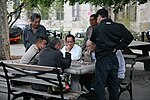The New York City draft riots (July 13–16, 1863), sometimes referred to as the Manhattan draft riots and known at the time as Draft Week, were violent disturbances in Lower Manhattan, widely regarded as the culmination of white working-class discontent with new laws passed by Congress that year to draft men to fight in the ongoing American Civil War. The riots remain the largest civil and most racially charged urban disturbance in American history.U.S. President Abraham Lincoln diverted several regiments of militia and volunteer troops after the Battle of Gettysburg to control the city. The rioters were overwhelmingly white working-class men who feared free black people competing for work and resented that wealthier men, who could afford to pay a $300 (equivalent to $6,300 in 2020) commutation fee to hire a substitute, were spared from the draft.Initially intended to express anger at the draft, the protests turned into a race riot, with white rioters attacking black people, in violence throughout the city. The official death toll was listed at either 119 or 120 individuals. Conditions in the city were such that Major General John E. Wool, commander of the Department of the East, said on July 16 that, "Martial law ought to be proclaimed, but I have not a sufficient force to enforce it."The military did not reach the city until the second day of rioting, by which time the mobs had ransacked or destroyed numerous public buildings, two Protestant churches, the homes of various abolitionists or sympathizers, many black homes, and the Colored Orphan Asylum at 44th Street and Fifth Avenue, which was burned to the ground. The area's demographics changed as a result of the riot. Many black residents left Manhattan permanently with many moving to Brooklyn. By 1865, the black population had fallen below 11,000 for the first time since 1820.









